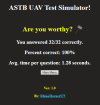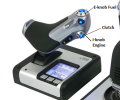I took the test today for my second time.
First attempt: 48 - 5/5/5 (12/19/2019)
Second attempt: 53 - 7/8/7 (2/25/2020)
Initially, I thought I was screwed, but my second score came to my surprise.
Because I got most of my degree done online, I really had to put a lot of effort into studying for this test. I studied full-time for about 4 months prior to my first attempt. After my failure, I took a few weeks off to relax before getting back into the game. During that time I also programmed my three practice simulators.
I had a hard time sleeping last night because I was so anxious, but at the same time super excited and eager to just get this test done once and for all. I got about 6 hours of sleep. I woke up and just ate a Cliff energy bar to tide myself over for the next 5 hours. I also ate a Snickers and drank some gatorade to give myself an energy boost shortly before I started. Do not eat too much, that got me my first test attempt. I ate pancakes and I was stuffed, big mistake! Just have a simple snack to tide you over.
What really helped was Kyle's ASTB Study Kit 2019, so take full advantage of it:
https://drive.google.com/drive/folders/1AvPi5oH_h_13TGajDvflDWkftwXO8LS6
Math:
Exponents, expressions, proportions, DRT problems, mixture problems, working-together problems, geometry, probabilities, and more.
If you're skeptical about your math abilities, no shame. Start fresh by watching all of MathAntics's videos on Youtube. You should also visit their website and run through their entire playlist. Then you need to really work on becoming fluent with algebraic word problems. Algebra is about solving for an unknown property. Every word problem involves an unknown property to solve for by writing an equation that represents the situation. Another Youtuber that was very helpful was The Organic Chemistry Tutor.
Watching Youtube videos, I learned more in one day than a semester back in High School.
I mean it, focus on the word problems!
Reading:
Just read and understand what the passage is saying. Go over each answer choice one by one and rule them out! Look for details in the answer choices that conflict with the passage.
Most of the readings were Navy policy and history. You don't need to be a lawyer to understand what the passage is saying.
Mechanical:
A lot of random questions involving air density, air pressure, voltage, mechanical advantage of levers, and too much for me to recall.
Some questions involved fluid flow and volume. For example, at which point of the narrowed funnel does water flow the fastest? How airplanes fly with pressure differentiation, what point of the trajectory has the greatest velocity, etc...
Some harder problems asked me how much an object of weight on Earth would weigh on Mars given the planet's "acceleration of mass m/s^2 yatayatayata." I had to guess. Don't spend more than 10 seconds determining if you can solve it or not. If you know for sure you can't solve it, just guess it and move on.
Make sure you understand how to determine the MA of all simple machines. To name a few that were most important:
First-Class Lever: L1 * F1 = L2 * F2
Second & Third-Class Lever: Middle Force * Middle Length / End Length = Lift/Push Force
Hydraulic Jack: Output Radius / Input Radius #It can also be diameter since they're proportional.
Pulley MA: Count ropes supporting the moveable pulley.
Drill them into your head!
Momentrix OAR really helped with my mechanical knowledge.
If you have an engineering degree and/or background, you're at a tremendous advantage.
ANIT:
Bunch of typical aviation and Navy stuff. "How did aircraft carriers evolve to support the F-14?" I'm assuming larger jet-blast deflectors, but that wasn't a choice, so I selected more powerful catapults. Some other answer choices I recall that made me laugh were "more powerful aircraft, larger flight decks." Another interesting question "what aircraft was retrofitted to be a tanker during Operation Iraqi Freedom? - Super Hornet?". Definitely not the Harrier, the Tomcat, or the "Avenger?" Other questions I recall were "Famous dive bomber - Dauntless," "If all VASI lights red - too low," airport tower signal lights, angle of attack, flight deck crew colors, and much more. The only nautical question I got was "What happens to the freeboard if you add more weight to the ship?"
Read the gouges, visit a museum, practice flashcards, and much more. These really helped:
https://www.cram.com/flashcards/tes...l-information-test-anit-comprehensive-4718163
BI-RV:
From what my recruiter told me, they recently did a software update to the test in Pensacola. They changed this section so now you just have to click the text to proceed to the next paired statement. That being said,
break your habit of double-clicking!!! This was explicitly warned in the test section's instructions.
Some questions were "I occasionally run stop signs when in a hurry," "I get mad easily...," "my car occasionally runs out of gas," and a lot more! Just try not to contradict yourself. Be patient and read before you answer. Pilots should follow checklists to save themselves and the plane. If not sure, just select the least destructive scenario.
PBMB:
I wasn't prepared for the PBMB my first attempt, which is what killed my score. I have no doubt my simulators improved my stamina and gave me some serious practice.
See my past posts for the simulators I published for the tracking portions, dichotic listening test, and UAV test.
Although my recruiter laughed, I brought my own pair of headphones just in case of even the slightest chance their headphones not working properly.
UAV Test:
I only missed one and that was because I heard someone laugh hysterically in the background which caught my attention off-guard. Take advantage of my UAV simulator. Create a strategy to answer each orientation in your head, rather than using the paper method. Make sure that you don't get them backwards like most people do. The red nose points to your heading, not the yellow tail!!! Run through my practice simulator repeatedly until your hand is sore! If you can train yourself to do them all in your head, you can get a score like this:
View attachment 24626
Dichotic Listening Test:
On the dichotic listening test, clear your ears by swallowing, take a breath, and relax. Focus your attention in the active target ear. Do not press any trigger until you hear both characters have played in both the left and right ears. This is due to latency by a few milliseconds between the audio being played in one ear before the other. At one point I was quick to depress a trigger on the joystick, but quickly realized that number I responded to was from the non-target ear. Don't rush yourself!
Needless to say, take advantage of my dichotic listening simulator!
Tracking & Emergency Scenarios Test:
I cannot stress this enough,
GET IN THE HABIT OF Y-AXIS LOOK INVERSION! If you play any FPS games like COD or Halo, set your look to inverted and deal with it! The Navy uses the Saitek X52 joystick. If this test means that much to you, I would even consider investing in one. I for one got the Logitech X56 HOTAS because I enjoy playing flight simulators as well.
For the Emergency Scenarios Test, memorize the emergency scenarios in your head. Repeat them even in your free time until they are drilled into your head!
View attachment 24622
FIRE:
-Fuel: LOW
-Power: LOW
-Press the clutch!
ENGINE:
-Fuel: HIGH
-Power: HIGH
-Press the clutch!
PROPELLOR:
-Fuel: NEUTRAL
-Power: HIGH
-Press the clutch!
After you've tested on all three emergency scenarios, the gauges will disappear and you will have about 30 seconds to continue the multi-tracking. During that time just hang in there and give it your best shot to maximize your score! It's like the final round in the game. Immediately after, you will receive your final ASTB score.
A frequently asked question is what positions do the colors on the gauges represent. RED - HIGH, GREEN - NEUTRAL, YELLOW - LOW. See attached "EST-Examinees-attempt-to-track.png"
Look at "EST-Examinees-attempt-to-track.png" and just imagine yourself crosshair tracking two flies simultaneously with a flight sim joystick.
If you're computer savvy, take advantage of the tracking visualizer I made and use JoyToKey with a flight simulator joystick and bind it to your mouse cursor. Remember to make the Y-axis inverted (Up goes down and down goes up).
Lastly, don't die by the gouge! Read the test instructions beforehand to ensure no discrepancies from you studied.
How often you practice shows how badly you want this career. Just don't schedule to take the ASTB until you're 100% comfortable with all of the material on this forum. Make the effort and research!



